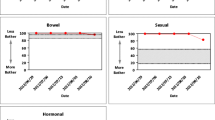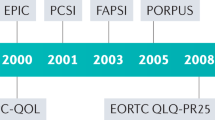Abstract
Purpose
Assessment of patient-reported outcomes (PROs), such as health-related quality of life, has become an important component of healthcare that measures the impact of disease and medical treatment on patient health. Collecting PROs during point-of-care assessments and integrating them into the clinical setting, however, remains challenging. The objective of this pilot study was to evaluate the reliability, usability, and acceptability of point-of-care electronic PRO assessments implemented in a prostate cancer clinic.
Methods
Fifty subjects completed paper–pencil and computerized formats of the Expanded Prostate Cancer Index Composite (EPIC), a validated, condition-specific QOL instrument, at separate times before treatment. Parallel-forms reliability was evaluated by comparing mean scores, variations in response distribution, and correlations between administration formats. Correlation coefficients of at least 0.70 were used for reliability testing. Differences between administration forms, indicating potential bias, were compared using the signed-rank test. A 6-item acceptability scale was also used to evaluate patient acceptability and satisfaction with the electronic format.
Results
Mean scores and standard deviations were similar between the paper–pencil and electronic forms across all EPIC instrument domains, and no assessment bias was found. Each EPIC domain demonstrated a high reliability between administration formats (correlation coefficients: 0.70–0.98). The majority (>90 %) of respondents found that the computerized QOL format was user friendly and simple to use.
Conclusions
Point-of-care computerized QOL assessments were reliable and acceptable to patients in this study, supporting the feasibility of PRO integration at the point-of-care in clinical settings.


Similar content being viewed by others
References
Santana, M. J., Haverman, L., Absolom, K., Takeuchi, E., Feeny, D., Grootenhuis, M., & Velikova, G. (2015). Training clinicians in how to use patient-reported outcome measures in routine clinical practice. Quality of Life Research, 24(7), 1707–1718.
Detmar, S. B., & Aaronson, N. K. (1998). Quality of life assessment in daily clinical oncology practice: A feasibility study. European Journal of Cancer, 34(8), 1181–1186.
Velikova, G., Booth, L., Smith, A. B., Brown, P. M., Lynch, P., Brown, J. M., & Selby, P. J. (2004). Measuring quality of life in routine oncology practice improves communication and patient well-being: A randomized controlled trial. Journal of Clinical Oncology, 22(4), 714–724.
Jensen, R. E., Snyder, C. F., Abernethy, A. P., Basch, E., Potosky, A. L., Roberts, A. C., et al. (2014). Review of electronic patient-reported outcomes systems used in cancer clinical care. Journal of Oncology Practice, 10(4), e215–e222.
Wu, A. W., Kharrazi, H., Boulware, L. E., & Snyder, C. F. (2013). Measure once, cut twice—Adding patient-reported outcome measures to the electronic health record for comparative effectiveness research. Journal of Clinical Epidemiology, 66(8 Suppl), S12–S20.
Silver, S. M. (2008). Cancer care for the whole patient-a new institute of medicine report. Journal of Oncology Practice, 4(3), 131.
Deyo, R. A., & Patrick, D. L. (1989). Barriers to the use of health status measures in clinical investigation, patient care, and policy research. Medical Care, 27(3 Suppl), S254–S268.
Hjollund, N. H., Larsen, L. P., Biering, K., Johnsen, S. P., Riiskjaer, E., & Schougaard, L. M. (2014). Use of patient-reported outcome (PRO) measures at group and patient levels: Experiences from the generic integrated PRO system, WestChronic. Interactive Journal of Medical Research, 3(1), e5.
Gwaltney, C. J., Shields, A. L., & Shiffman, S. (2008). Equivalence of electronic and paper-and-pencil administration of patient-reported outcome measures: A meta-analytic review. Value in Health, 11(2), 322–333.
Velikova, G. (2004). Use of electronic quality of life applications in cancer research and clinical practice. Expert Review of Pharmacoeconomics & Outcomes Research, 4(4), 403–411.
Velikova, G., Brown, J. M., Smith, A. B., & Selby, P. J. (2002). Computer-based quality of life questionnaires may contribute to doctor-patient interactions in oncology. British Journal of Cancer, 86(1), 51–59.
Davis, K. M., Kelly, S. P., Luta, G., Tomko, C., Miller, A. B., & Taylor, K. L. (2014). The association of long-term treatment-related side effects with cancer-specific and general quality of life among prostate cancer survivors. Urology, 84(2), 300–306.
Hamoen, E. H., De Rooij, M., Witjes, J. A., Barentsz, J. O., & Rovers, M. M. (2015). Measuring health-related quality of life in men with prostate cancer: A systematic review of the most used questionnaires and their validity. Urologic Oncology, 33(2), 69-e19–69-e28.
Montague, D. K., Barada, J. H., Belker, A. M., Levine, L. A., Nadig, P. W., Roehrborn, C. G., et al. (1996). Clinical guidelines panel on erectile dysfunction: Summary report on the treatment of organic erectile dysfunction. The American Urological Association. The Journal of Urology, 156(6), 2007–2011.
Rosen, R. C., Riley, A., Wagner, G., Osterloh, I. H., Kirkpatrick, J., & Mishra, A. (1997). The international index of erectile function (IIEF): A multidimensional scale for assessment of erectile dysfunction. Urology, 49(6), 822–830.
Litwin, M. S., Hays, R. D., Fink, A., Ganz, P. A., Leake, B., & Brook, R. H. (1998). The UCLA Prostate Cancer Index: Development, reliability, and validity of a health-related quality of life measure. Medical Care, 36(7), 1002–1012.
Wei, J. T., Dunn, R. L., Litwin, M. S., Sandler, H. M., & Sanda, M. G. (2000). Development and validation of the expanded prostate cancer index composite (EPIC) for comprehensive assessment of health-related quality of life in men with prostate cancer. Urology, 56(6), 899–905.
Gilbert, S. M., Dunn, R. L., Wittmann, D., Montgomery, J. S., Hollingsworth, J. M., Miller, D. C., et al. (2015). Quality of life and satisfaction among prostate cancer patients followed in a dedicated survivorship clinic. Cancer, 121(9), 1484–1491.
Chang, P., Szymanski, K. M., Dunn, R. L., Chipman, J. J., Litwin, M. S., Nguyen, P. L., et al. (2011). Expanded prostate cancer index composite for clinical practice: Development and validation of a practical health related quality of life instrument for use in the routine clinical care of patients with prostate cancer. Journal of Urology, 186(3), 865–872.
Lewis, J. R. (1995). IBM computer usability satisfaction questionnaires: Psychometric evaluation and instructions for use. International Journal of Human–Computer Interaction, 7(1), 57–78.
Blum, D., Raj, S. X., Oberholzer, R., Riphagen, II, Strasser, F., Kaasa, S., & Euro Impact, E. I. M. P. C. R. T. (2014). Computer-based clinical decision support systems and patient-reported outcomes: A systematic review. The Patient-Patient-Centered Outcomes Research. doi:10.1007/s40271-014-0100-1.
Tariman, J. D., Berry, D. L., Halpenny, B., Wolpin, S., & Schepp, K. (2011). Validation and testing of the acceptability E-scale for web-based patient-reported outcomes in cancer care. Applied Nursing Research, 24(1), 53–58.
Mohler, J., Bahnson, R. R., Boston, B., Busby, J. E., D’Amico, A., Eastham, J. A., et al. (2010). NCCN clinical practice guidelines in oncology: Prostate cancer. Journal of the National Comprehensive Cancer Network, 8(2), 162–200.
Basch, E., & Abernethy, A. P. (2011). Supporting clinical practice decisions with real-time patient-reported outcomes. Journal of Clinical Oncology, 29(8), 954–956.
Efficace, F., Jacobs, M., Pusic, A., Greimel, E., Piciocchi, A., Kieffer, J. M., et al. (2014). Patient-reported outcomes in randomised controlled trials of gynaecological cancers: Investigating methodological quality and impact on clinical decision-making. European Journal of Cancer, 50(11), 1925–1941.
Basch, E., Artz, D., Dulko, D., Scher, K., Sabbatini, P., Hensley, M., et al. (2005). Patient online self-reporting of toxicity symptoms during chemotherapy. Journal of Clinical Oncology, 23(15), 3552–3561.
Velikova, G., Wright, E. P., Smith, A. B., Cull, A., Gould, A., Forman, D., et al. (1999). Automated collection of quality-of-life data: A comparison of paper and computer touch-screen questionnaires. Journal of Clinical Oncology, 17(3), 998–1007.
Rutherford, C., Mercieca-Bebber, R., Rice, H., Costa, D., & King, M. (2014). Mode of administration of patient-reported outcomes (pro) measures: A systematic review. In Paper presented at the Asia–Pacific Journal of Clinical Oncology.
Vickers, A. J., Savage, C. J., Shouery, M., Eastham, J. A., Scardino, P. T., & Basch, E. M. (2010). Validation study of a web-based assessment of functional recovery after radical prostatectomy. Health Quality Life Outcomes, 8, 82.
Abernethy, A. P., Herndon, J. E, 2nd, Wheeler, J. L., Day, J. M., Hood, L., Patwardhan, M., et al. (2009). Feasibility and acceptability to patients of a longitudinal system for evaluating cancer-related symptoms and quality of life: Pilot study of an e/Tablet data-collection system in academic oncology. Journal of Pain and Symptom Management, 37(6), 1027–1038.
McCann, L., Maguire, R., Miller, M., & Kearney, N. (2009). Patients’ perceptions and experiences of using a mobile phone-based advanced symptom management system (ASyMS) to monitor and manage chemotherapy related toxicity. European Journal of Cancer Care, 18(2), 156–164.
Litwin, M. S., & McGuigan, K. A. (1999). Accuracy of recall in health-related quality-of-life assessment among men treated for prostate cancer. Journal of Clinical Oncology, 17(9), 2882–2888.
Judson, T. J., Bennett, A. V., Rogak, L. J., Sit, L., Barz, A., Kris, M. G., et al. (2013). Feasibility of long-term patient self-reporting of toxicities from home via the Internet during routine chemotherapy. Journal of Clinical Oncology, 31(20), 2580–2585.
Nama, V., Nordin, A., & Bryant, A. (2013). Patient-reported outcome measures for follow-up after gynaecological cancer treatment. Cochrane Database System Review, 11, CD010299.
Gregorich, S. E. (2006). Do self-report instruments allow meaningful comparisons across diverse population groups? Testing measurement invariance using the confirmatory factor analysis framework. Medical Care, 44(11 Suppl 3), S78–S94.
Acknowledgments
Supported, in part, by the American Urological Association Foundation.
Author information
Authors and Affiliations
Corresponding author
Ethics declarations
Conflict of interest
The authors declare that they have no conflict of interest.
Ethical approval
All procedures performed in studies involving human participants were in accordance with the ethical standards of the institutional and/or national research committee and with the 1964 Helsinki declaration and its later amendments or comparable ethical standards.
Rights and permissions
About this article
Cite this article
Sharma, P., Dunn, R.L., Wei, J.T. et al. Evaluation of point-of-care PRO assessment in clinic settings: integration, parallel-forms reliability, and patient acceptability of electronic QOL measures during clinic visits. Qual Life Res 25, 575–583 (2016). https://doi.org/10.1007/s11136-015-1113-5
Accepted:
Published:
Issue Date:
DOI: https://doi.org/10.1007/s11136-015-1113-5




